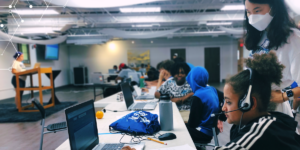A new ISI agent project aims to turn “user friendly” into more than a catchphrase.
The National Science Foundation (NSF) has awarded $1.4 million to an interdisciplinary team headed by artificial intelligence expert W. Lewis Johnson to develop computer programs that can respond to people’s expressed emotions as well as their words.”One of our most important capabilities as human beings is our social intelligence, our ability to interact effectively with other people,” explains Johnson, director of ISI’s Center for Advanced Research in Technology for Education (CARTE). “The aim of this project is to develop social intelligence skills for computers. This is important because people must interact constantly with information technology, and even modern computers have only a limited ability to interact socially with people.”
CARTE has designed specially written programs to serve as robot instructors for human students. The programs, called “agents,” appear as animated characters on a monitor. They can not only speak to people, but can also understand replies, and thus carry on non-trivial conversations. Johnson’s team has built several such agents, including two named “Steve” and “Adele” to teach various kinds of learners, including medical students and military personnel.
But Johnson says the social element is important to make Steve, Adele and future robot teachers less robotic. “Educational software that lacks social intelligence may make incorrect assumptions about the learner’s motivational state, or use sound and visual effects that distract and do not really address the learner’s motivational problems.” The answer? “We therefore plan to focus on social intelligence in educational software, to create software that interacts harmoniously and responds to learner needs, that is able to develop rapport with learners, and that uses responsiveness and rapport to influence learner motivation.
“Animated pedagogical agents, he continues, “use a combination of speech and nonverbal gestures when communicating with learners. They can express emotions and attitudes, making messages more personal and effective. However such agents to date only offer the illusion of social intelligence, since the agents cannot respond to the learners’ emotions and attitudes; this illusion can break down if the agent fails to react appropriately and does not adapt over time. By integrating social intelligence into animated agents, we can create agents that are capable of rich two-way interaction and are even more effective in promoting learning.”
Johnson’s team includes two faculty members from the USC School of Engineering: Professor Christoph von der Malsburg of the department of computer science and Associate Professor Maged Dessouky of the department of industrial and systems engineering department; ISI research associates Jeff Rickel, Erin Shaw, and Kate LaBore; and Richard Mayer, a professor in the University of California Santa Barbara department of psychology.
Published on October 19th, 2001
Last updated on August 10th, 2021












